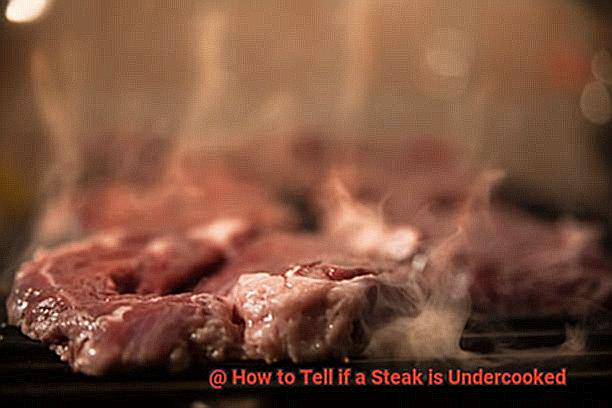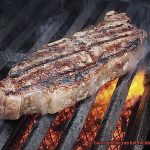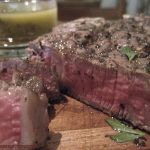Have you ever bitten into a steak, only to realize it’s undercooked?
It can be disappointing, even for experienced chefs and meat lovers. But fear not.
Knowing how to tell if a steak is undercooked will not only save you from disappointment but also from potential health risks. While medium-rare steaks are packed with flavor and tenderness, undercooked steaks can harbor harmful bacteria.
So, how do you know if your steak is cooked to perfection? There are several signals to watch out for, including color, texture, temperature, and feel.
In this article, we’ll explore the different ways to tell if a steak is undercooked. We’ll cover everything from visually inspecting the meat to using a meat thermometer.
Plus, we’ll discuss the various doneness levels of steak – rare, medium-rare, medium, medium-well, and well-done.
So, let’s get started.
Contents
What is Undercooked Steak?
Undercooked steak refers to meat that hasn’t reached the recommended internal temperature, making it a breeding ground for harmful bacteria such as E.coli and salmonella.
These bacteria can cause food poisoning and lead to severe health issues. When cooking steak, there are three main factors to consider: texture, color, and temperature.
An undercooked steak will be soft and rubbery, while a fully cooked steak will be firm and juicy. In terms of color, a rare steak will have a bright red center, while a well-done steak will have no pink at all.
Temperature is perhaps the most crucial factor in determining whether your steak is undercooked. It’s best to use a meat thermometer to ensure your steak reaches the recommended internal temperature for safe consumption.
For instance, a rare steak should have an internal temperature of 125°F (51°C), whereas medium-rare steaks should reach 135°F (57°C). Medium steaks should be prepared to an internal temperature of 145°F (63°C), while well-done steaks should reach 160°F (71°C).
However, these temperatures are only guidelines, and personal preferences may vary. Always ask about preferred levels of doneness when cooking steak.
It’s better to err on the side of caution and overcook rather than risk consuming undercooked meat. It’s essential to note that undercooked steak may not always be visible to the naked eye.
Some cuts may appear cooked on the outside but remain raw on the inside. Therefore, using a meat thermometer is crucial in ensuring that your steak reaches a safe internal temperature.
Consuming undercooked steak can lead to symptoms such as nausea, vomiting, diarrhea, and stomach cramps. In severe cases, it can even lead to hospitalization.
Pay close attention to your steak’s texture, color, and temperature when cooking. By doing so, you’ll ensure that your steak is cooked to perfection and safe for consumption.
Factors to Consider When Determining if a Steak is Undercooked
Cooking the perfect steak requires more than just throwing it on the grill and hoping for the best.
One of the most important considerations is determining whether your steak is undercooked. Fortunately, there are several factors to keep in mind that can help ensure your steak is cooked to perfection.
First and foremost, temperature is crucial. To avoid any potential health risks, use a meat thermometer to check that the internal temperature of your steak meets the recommended guidelines.
For medium-rare, aim for at least 130°F, while medium should be 140°F, and well-done 160°F. Just remember to insert the thermometer into the thickest part of the steak without touching any bones to get an accurate reading.
The color and texture of your steak can also give you clues as to whether it’s undercooked. A properly cooked steak should have a brown crust on the outside and be pink or red on the inside, depending on your preference.
If it’s gray or brown throughout, it may be overcooked. In terms of texture, the steak should be firm but still slightly tender.

Thickness can also impact how long it takes to cook a steak properly. Thicker steaks will take longer to cook than thinner ones, so adjust your cooking time accordingly.
For thicker steaks, sear them on both sides before moving them to a lower heat to ensure that they cook evenly without burning on the outside.
Lastly, don’t forget to let your steak rest after cooking. Cutting into your steak too soon can cause it to lose those precious juices, resulting in a dry and tough piece of meat.
Texture of an Undercooked Steak
Texture is the key to determining if your steak is undercooked.
An undercooked steak has a soft and squishy texture, which is quite different from the firm and slightly springy texture of a perfectly cooked steak. Give it a try.
Press down on your steak with your finger to check for an indentation. If it’s there and takes a few seconds to fill back in, then it’s likely undercooked.
Also, take a look at the meat’s color. A pink or red hue is a clear indication that your steak hasn’t been cooked long enough.
But why rely on guesswork when you can use a meat thermometer to determine the internal temperature of your steak? Rare steak should be around 125°F, while medium-rare should be around 135°F.
If your steak’s internal temperature is below these levels, then it’s likely undercooked. Keep in mind that eating undercooked meat can be hazardous to your health as it can contain harmful bacteria that can cause food poisoning.
So, if you’re unsure about your steak’s texture or internal temperature, it’s always best to err on the side of caution and cook it a little longer. It’s better to have a well-cooked steak than to risk getting sick from undercooked meat.
The texture of an undercooked steak is soft and squishy, leaving an indentation when pressed with a finger. Additionally, the meat may have a pink or red hue.
To ensure that you have a perfectly cooked steak every time, use a meat thermometer and cook it for longer if necessary.
Color of an Undercooked Steak
Color is the key indicator of doneness when it comes to steak. Just like turning the pages of a book, each color tells a different part of the story.
When it comes to undercooked steak, expect to see a red or pink center. But don’t be fooled.
Not all shades of red or pink are created equal. The color of a steak and how it’s been cooked will vary depending on the type of steak and how it was cooked.
For example, a rare steak is like the first bloom of a rose with a brilliant red center. A medium-rare steak has a slightly pink center, more like a delicate blush.
A medium steak will have a mostly pink center with a hint of brown, reminiscent of a sunset on the horizon. And if you prefer your steak well-done, the color will be brown throughout, like the bark on an old oak tree.
But what if you’re dealing with a naturally darker type of beef, such as wagyu or grass-fed? In these situations, relying on color alone may not be enough.
Use other measures such as firmness and internal temperature to ensure that your steak is cooked to perfection.
Temperature of an Undercooked Steak
First things first, to measure your steak’s internal temperature, you need a trusty tool. Enter the meat thermometer – the ultimate sidekick on your quest for a perfectly cooked steak.
This device accurately measures the internal temperature of your steak, which is crucial in determining if it’s undercooked. To use a meat thermometer, insert it into the thickest part of your steak, making sure not to touch any bones or the pan.
Ensure that it’s deep enough to get an accurate reading, but not too deep that it leads to a false conclusion. For a medium-rare steak, the ideal temperature is between 130 and 135 degrees Fahrenheit.
If your thermometer reads below this temperature, your steak is likely undercooked. But what if you don’t have a meat thermometer?
You can also use touch to determine if your steak is undercooked.
Gently press your finger against the center of your steak – if it feels squishy or soft, it’s likely that it’s still rare or undercooked. As the steak cooks, it will become firmer to the touch.
However, different cuts of steak may have varying preferred temperatures. For instance, a filet mignon may require a slightly lower temperature than a ribeye.
To ensure that you’re cooking your steak to perfection, consult a cooking chart or conduct some research on the optimal temperature range for your specific cut of meat. It’s important to note that relying solely on touch can be less reliable than using a meat thermometer.
The texture of your steak may vary depending on factors such as its thickness and cut, making it challenging to accurately gauge its internal temperature through touch alone.
Tips for Perfectly Cooking a Steak
Cooking the perfect steak can be a daunting task, but with the right tips and tricks, you can achieve a delicious and succulent steak every time. Here are seven tips to help you cook the perfect steak:
Choose the Right Cut of Meat
The quality of your steak will depend on the cut of meat you choose. Look for marbling, which is the small white flecks throughout the steak that add flavor and tenderness. The most popular cuts for grilling are ribeye, sirloin, and filet mignon.
Let Your Steak Come to Room Temperature
Before cooking your steak, let it sit at room temperature for at least 30 minutes. This will ensure that the steak cooks evenly and retains its juices.
Season Your Steak Liberally
Season your steak generously with salt and pepper on both sides before cooking. You can also add herbs or spices for extra flavor.
Use a Heavy-Bottomed Pan or Grill
For the best sear, use a heavy-bottomed pan or grill. Cast iron pans are ideal as they distribute heat evenly and retain high temperatures.
Cook Over High Heat
Sear your steak over high heat for a few minutes on each side until it is nicely browned. This will give your steak a caramelized crust and seal in the juices.
Check the Internal Temperature
To ensure that your steak is cooked to your liking, check its internal temperature with a meat thermometer or touch test. For rare, aim for 125°F (52°C), for medium-rare 130-135°F (54-57°C), for medium 135-145°F (57-63°C), and for well-done around 160°F (71°C).
Rest Your Steak Before Serving
After cooking, let your steak rest for at least five minutes before slicing into it. This will allow the juices to redistribute throughout the steak, resulting in a tender and juicy cut of meat.
kREW0RlftUw” >
Conclusion
In conclusion, crafting a mouth-watering steak requires more than just guesswork and hope.
It demands precision and patience to ensure that the meat is cooked to perfection. Not only is it crucial to know how to tell if a steak is undercooked for taste, but also for safety reasons.
Consuming undercooked steaks can lead to food poisoning and severe health concerns due to potential toxins. To identify if your steak is undercooked, you must consider various factors such as color, texture, and temperature.
When pressed with a finger, an undercooked steak will feel soft and squishy, leaving an indentation. Depending on your preferred level of doneness, the inside of an undercooked steak will be red or pink in color.
Temperature plays a pivotal role in determining whether your steak is safe for consumption or not. Always use a meat thermometer to guarantee that your steak reaches the appropriate internal temperature.






